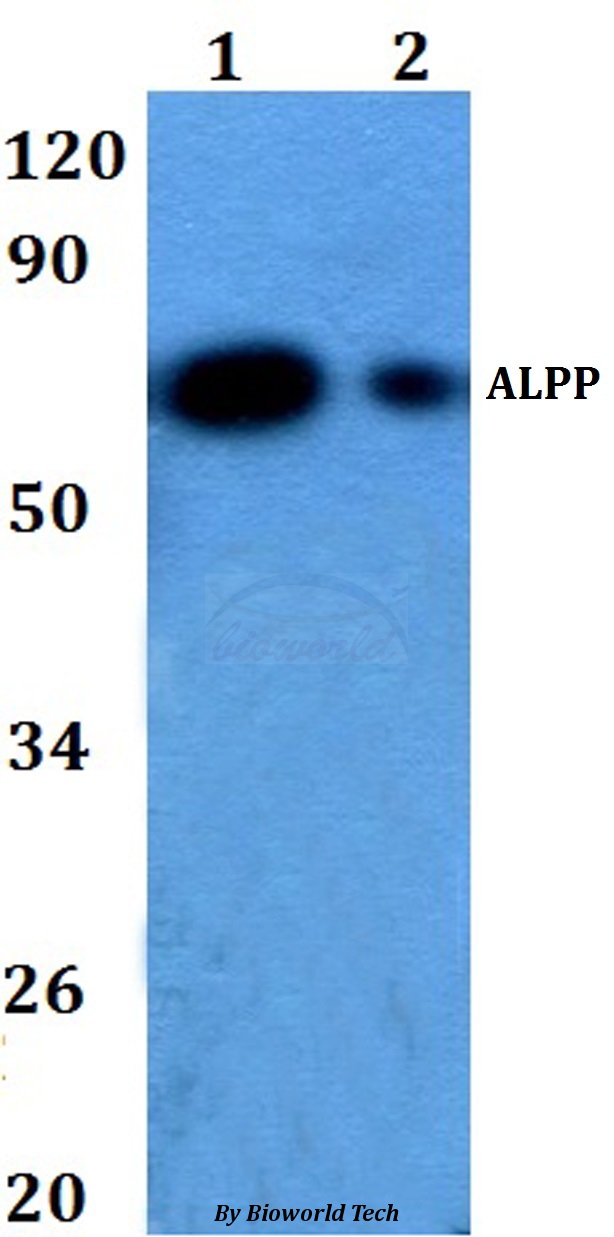Placental Alkaline Phosphatase antibody
GTX72989
ApplicationsImmunoPrecipitation, Western Blot, ImmunoHistoChemistry, ImmunoHistoChemistry Frozen, ImmunoHistoChemistry Paraffin
Product group Antibodies
TargetALPP
Overview
- SupplierGeneTex
- Product NamePlacental Alkaline Phosphatase antibody
- Delivery Days Customer9
- Application Supplier NoteImmunoblot 1:100-1:500. Immunoprecipitation, Immunohistochemistry 1:50. The optimal conditions should be determined by the individual laboratory. This antibody can be used on formalin-fixed, paraffin-embedded tissue sections. Prolonged fixation in buffered formalin can destroy the epitope. The antibody may be used at a dilution of 1:50 with AutoProbe III (GTX28620). It is recommended that this product be used on frozen tissue sections or specimens. The optimal conditions should be determined by the individual laboratory.
- ApplicationsImmunoPrecipitation, Western Blot, ImmunoHistoChemistry, ImmunoHistoChemistry Frozen, ImmunoHistoChemistry Paraffin
- CertificationResearch Use Only
- ClonalityPolyclonal
- Concentration0.2 mg/ml
- ConjugateUnconjugated
- Gene ID250
- Target nameALPP
- Target descriptionalkaline phosphatase, placental
- Target synonymsALP, ALPI, IAP, PALP, PLAP, PLAP-1, alkaline phosphatase, placental type, Intestinal alkaline phosphatase, Intestinal-type alkaline phosphatase, alkaline phosphatase Regan isozyme, alkaline phosphomonoesterase, glycerophosphatase, placental alkaline phosphatase 1
- HostRabbit
- IsotypeIgG
- Protein IDP05187
- Protein NameAlkaline phosphatase, placental type
- Scientific DescriptionThe protein encoded by this gene is an alkaline phosphatase, a metalloenzyme that catalyzes the hydrolysis of phosphoric acid monoesters. It belongs to a multigene family composed of four alkaline phosphatase isoenzymes. The enzyme functions as a homodimer and has a catalytic site containing one magnesium and two zinc ions, which are required for its enzymatic function. The protein is primarily expressed in placental and endometrial tissue; however, strong ectopic expression has been detected in ovarian adenocarcinoma, serous cystadenocarcinoma, and other ovarian cancer cells. [provided by RefSeq, Jan 2015]
- Storage Instruction2°C to 8°C
- UNSPSC12352203
References
- Kohno T, Ishii K, Hirota Y, et al. Reelin-Nrp1 Interaction Regulates Neocortical Dendrite Development in a Context-Specific Manner. J Neurosci. 2020,40(43):8248-8261. doi: 10.1523/JNEUROSCI.1907-20.2020Read this paper
- Satué M, Schüler C, Ginner N, et al. Intra-articularly injected mesenchymal stem cells promote cartilage regeneration, but do not permanently engraft in distant organs. Sci Rep. 2019,9(1):10153. doi: 10.1038/s41598-019-46554-5Read this paper
- Zwolanek D, Satué M, Proell V, et al. Tracking mesenchymal stem cell contributions to regeneration in an immunocompetent cartilage regeneration model. JCI Insight. 2017,2(20):pii: 87322. doi: 10.1172/jci.insight.87322.Read this paper
- Kohno T, Honda T, Kubo K, et al. Importance of Reelin C-terminal region in the development and maintenance of the postnatal cerebral cortex and its regulation by specific proteolysis. J Neurosci. 2015,35(11):4776-87. doi: 10.1523/JNEUROSCI.4119-14.2015Read this paper




![IHC-P analysis of human seminoma tissue using GTX01925 Placental Alkaline Phosphatase antibody [8A9]. Note the strong membrane and cytoplasmic staining of malignant cells.](https://www.genetex.com/upload/website/prouct_img/normal/GTX01925/GTX01925_20200811_IHC-P_72_w_23053121_545.webp)
![IHC-P analysis of ovarian cancer (A), stomach cancer (B) using GTX82823 Placental Alkaline Phosphatase antibody [3E5].](https://www.genetex.com/upload/website/prouct_img/normal/GTX82823/GTX82823_20170912_IHC-P_w_23051501_584.webp)